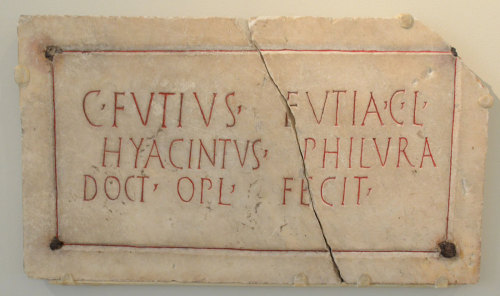apuleiaprimilla: The first columbarium slab marked the tomb of Futius Hyacintus who was an instructo
apuleiaprimilla:The first columbarium slab marked the tomb of Futius Hyacintus who was an instructor in a gladiatorial school. It reads: C(aius) Futius / Hyacintus / doct(or) (h)opl(omachorum) // Futia C(ai) l(iberta) / Philura / fecit, meaning “Gaius Futius Hyacintus, Instructor of the Oplomachi [lies here]. Futia Philura, freedwoman of Gaius, made this.”He appears to have trained the Oplomachi, a specific type of gladiator. Not much is known about the equipment of these fighters, but they may have been similar to the Samnite type. Samnites fought with a sword, and were protected by a rectangular shield, greaves, and a helmet. The tomb was set up by a freedwomen of his, by the name of Futia Philura.The second slab marked the burial niche of a Gaius Futius Philargyrus. It reads: C(aius) Futius C(ai) l(ibertus) / Philargyrus / doc(tor) vel(itum), meaning “Gaius Futius Philargyrus, freedman of Gaius, Instructor of the Velites”.It was found together with the inscription for Gaius Futius Hyacintus. Both men share the Name Futius, which may indicate that they were freedmen of the same man. It was customary that freedman adopted the nomen gentile of their former master. Like Gaius Futius Hyacintus, this man was also a trainer. The term Velites can apply to a type of soldier or gladiator, but the find context suggests that he trained gladiators.1st century AD, found in Rome, near Porta Salaria.@ The Johns Hopkins Archaeological Museum, Baltimore -- source link
Tumblr Blog : apuleiaprimilla.tumblr.com
#gladiators#columbarium

